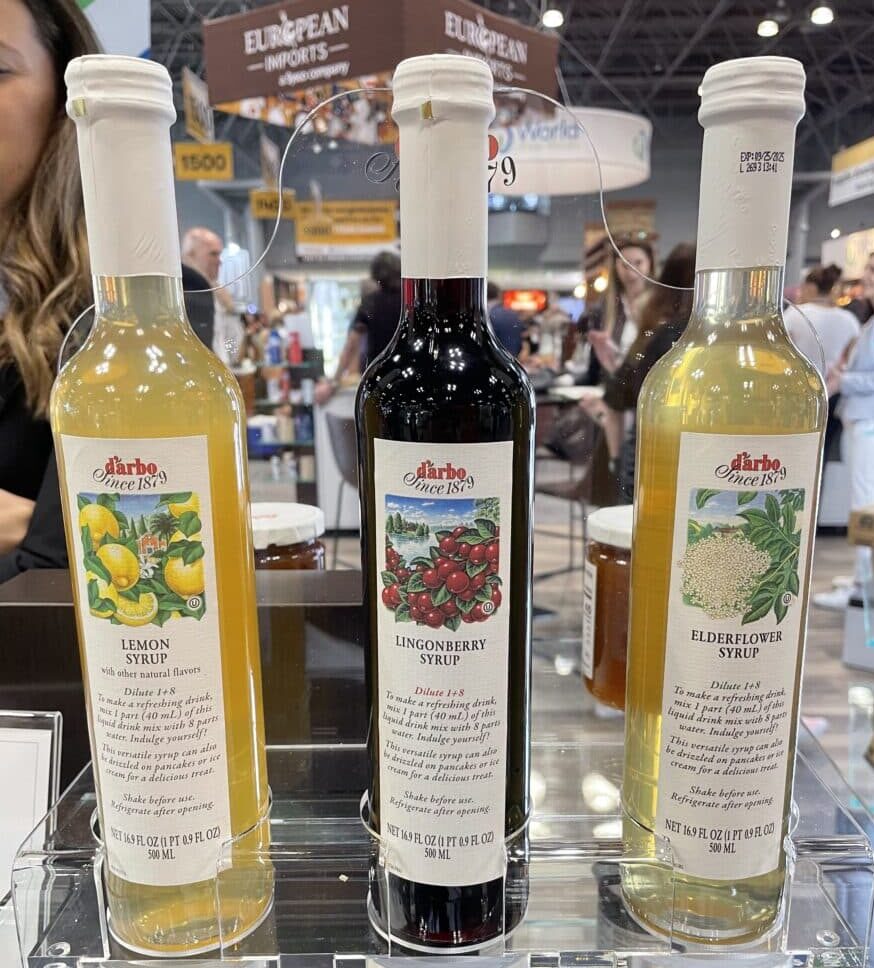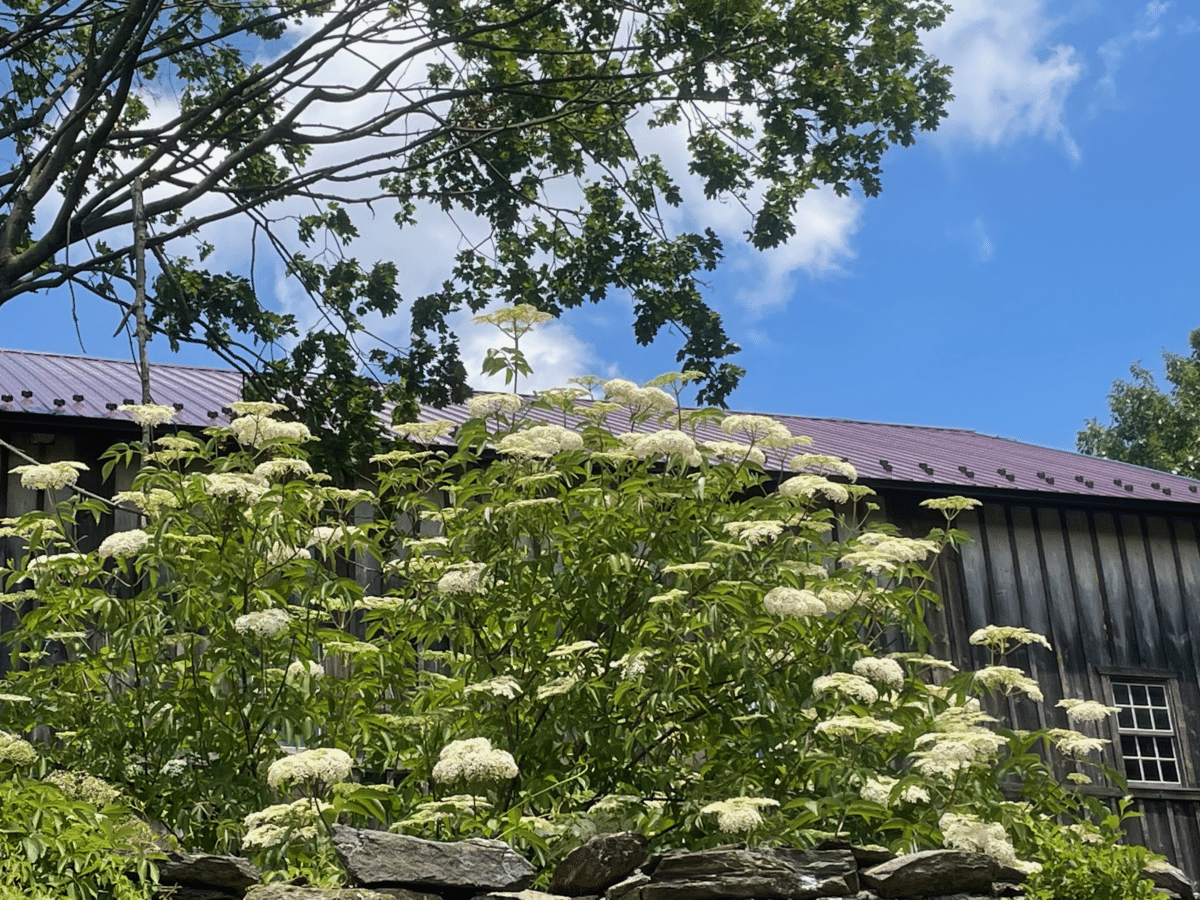Elder plants, flowers, and berries
My first (late-in-life) introduction to elder plants began with the elderberries, when I received a neighborly offer of elderberry jam in exchange for asparagus plants. Another neighbor donated and planted three shrubs for me. Little did I know, but I already had mature elderberry trees a few feet away. The new ones have have thrived over the past several years, and I look forward each summer to picking the ripe berries for syrup and jam.
However, I only recently learned of the potential of elderflowers, which are harvested from the same plant at an earlier stage. I hadn’t actually considered gathering these delicate blossoms myself until I read about them in Mark Diacono’s Garden to Table.
Is there a more glorious sight in May than – from just far enough away that you can be sure – an elder covered in scrunched hanky flowerheads, knowing dozens are within tiptoed reach?
Bagless, I tied my shirt at the cuffs, tucked the collar into the knot, and in three short minutes filled the makeshift bag with bold, upright heads. A minute into the two minute drive back to the house, I had to wind the window down, so heady was their scent.
30 seconds after walking through the door, they are in gin, for 100 minutes only, to release the essence of May into the booze as the heavens opened.
Elderflowers are aromatic, offering a light, subtle floral flavor. Intrigued by the descriptive prose and recipe for Elderflower Cordial, I continued to research, and learned that they can also add a distinctive touch to baked goods.
As a city-to-farm-life transplant, I realize daily how little I know about nature’s bounty. The small (and large) discoveries are astonishing. When I reported this new discovery to my husband, he said, “I’m sure Grammy would have known all about this.”
Unknown content block type: FlexiblePageTemplateFlexibleContentPhotoFullWidthLayout
{
"__typename": "FlexiblePageTemplateFlexibleContentPhotoFullWidthLayout"
}Health benefits and safety
Elderflowers have reputed health benefits as well as flavor. They’re used in remedies for ailments like the common cold and influenza, and can be applied topically for joint pain and inflammation. Given their dual benefits—both edible and topical—they seem too promising to overlook.
I was particularly glad to know that while elderberries must be cooked to be safe, due to their toxic raw state, elderflowers do not share this restriction. This makes them even more appealing for culinary experimentation.
In my area in Pennsylvania, my lovely bright white flowers emerged in mid-June and lasted about two weeks. They turned gradually darker as the berries began to emerge. The consistent return each season of the beautiful shrubs that require no care, plus their safe and potentially healthful nature, makes elderflowers a compelling subject for further exploration in my kitchen. I followed Nicola Lamb’s extensive and detailed advice in her Kitchen Project #70: Elderflower buns —The perfect cordial ratio & how to use cordial in your bread.
I am the first person to admit I’m no expert forager, but elderflowers are so ubiquitous this time of year that I can’t help but arm myself with a bag and a pair of scissors when I’m off on a walk.
Elder trees grow across the country, popping up in parks and fields – it’s a tree with dark green leaves and abundantly bushy flowering heads. These creamy white flowering heads are the elderflowers, which carry a perfumed scent and flavour. Later in the summer, the trees sprout elderberries, a dark purple fruit. The elderflowers can be made into fritters, or processed into cordial, syrups or wine, and the elderberries can be processed similarly.
Elderflowers come from the same plant as elderberries, known as the elder or elderberry bush. These blossoms are the earlier growth stage of the plant, appearing in late spring to early summer, depending on the climate. Elderflowers are small, creamy-white, and grow in clusters. They’re known for their light, subtly sweet fragrance and flavor, which is less intense than the bold, tangy taste of elderberries that develop later in the season.
Elderflowers grow in much of Europe and North America. These plants prefer moist, well-drained soil and are often seen in hedgerows and woodlands.
In comparison to elderberries, which need to be cooked to be safely consumed due to their cyanogenic glycosides (toxic substances found in raw berries), elderflowers are safe to use fresh. This makes them more accessible for quick culinary uses. While elderberries are lauded for their vitamin C and antioxidant content, elderflowers offer their own unique set of uses and benefits, making both parts of the plant valuable in different ways.

In the kitchen, they’re often made into syrups, cordials, or infused into spirits like gin.
Elderflower cordial, a sweet drink made by steeping the flowers in a sugar syrup with lemon, is a popular recipe. This cordial can be diluted with water for a refreshing beverage or used in cocktails.
At the Summer Fancy Food Show, an exhibitor told me she used the commercially bottled d’arbo brand elderberry syrup in place of Aperol for a prosecco spritz. The taste I sampled was just a bit sweeter than the version I made, but otherwise very similar. In addition to drinks, elderflowers are sometimes added to desserts for a floral note, such as in cakes or custards. I added some to my pancake batter this morning. It makes a subtle citrusy whipped cream that is a treat when dolloped on parfaits, grilled fruit, puddings, cupcakes, and more. As a bonus, the delicate edible flowers can be scattered on baked goods for a festive touch.
